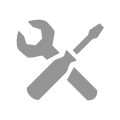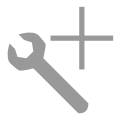Creating a custom tool
GeoGebra allows you to create your own  Custom Tools based on an existing construction. This means that you can extend the toolbar by creating your own tools.
Once created, your Custom Tool can be used both with the mouse and as a command in the Input Bar. All Custom Tools are automatically saved in your GeoGebra file.
Custom Tools based on an existing construction. This means that you can extend the toolbar by creating your own tools.
Once created, your Custom Tool can be used both with the mouse and as a command in the Input Bar. All Custom Tools are automatically saved in your GeoGebra file.
 Custom Tools based on an existing construction. This means that you can extend the toolbar by creating your own tools.
Once created, your Custom Tool can be used both with the mouse and as a command in the Input Bar. All Custom Tools are automatically saved in your GeoGebra file.
Custom Tools based on an existing construction. This means that you can extend the toolbar by creating your own tools.
Once created, your Custom Tool can be used both with the mouse and as a command in the Input Bar. All Custom Tools are automatically saved in your GeoGebra file.Creating a custom tool
First, create the construction your tool should be able to create later on. In the  Tools menu, select
Tools menu, select  Create New Tool to open the corresponding dialog. Now you need to fill in the three tabs Output Objects, Input Objects, and Name and Icon to create your custom tool.
Create New Tool to open the corresponding dialog. Now you need to fill in the three tabs Output Objects, Input Objects, and Name and Icon to create your custom tool.
 Tools menu, select
Tools menu, select  Create New Tool to open the corresponding dialog. Now you need to fill in the three tabs Output Objects, Input Objects, and Name and Icon to create your custom tool.
Create New Tool to open the corresponding dialog. Now you need to fill in the three tabs Output Objects, Input Objects, and Name and Icon to create your custom tool.Task
Let’s now create a tool that determines the minimal distance between a line and a point (e.g. altitude in a triangle).
Before you can create your custom tool you need to construct all the objects required for your tool.
Instructions
| 1. |  | Open the  Menu in the top right corner and select Tools. Menu in the top right corner and select Tools.
|
| 2. |  | Select Create New Tool to open the Create New Tool dialog. |
| | | Note: By default, tab Output Objects is activated. |
| 3. | | Specify the output objects of your new tool by either selecting the desired output object in the Graphics View (example below: segment c) or selecting it from the drop down menu (click on the little arrow next to the input field). |
| 4. | | Click the Next > button to activate tab Input Objects. |
| 5. | | GeoGebra fills in the corresponding input objects for your tool automatically (example below: points A, B and C). |
| 6. | | Click the Next > button to activate tab Name & Icon. |
| 7. | | Fill in the name Altitude for your tool and a text for the Tooltip (e.g. Click on three points). |
| | | Note: GeoGebra fills in the text field Command name automatically.. |
| 8. | | Click the Finish button to confirm. |
Try it yourself...
Saving your custom tool
You can save your custom tools so you can reuse them in other GeoGebra constructions. In the Tools menu, select  Manage Tools to open the dialog. Then, select the custom tool you want to save from the appearing list. Select Save As… to save your custom tool on your computer.
Manage Tools to open the dialog. Then, select the custom tool you want to save from the appearing list. Select Save As… to save your custom tool on your computer.
 Manage Tools to open the dialog. Then, select the custom tool you want to save from the appearing list. Select Save As… to save your custom tool on your computer.
Manage Tools to open the dialog. Then, select the custom tool you want to save from the appearing list. Select Save As… to save your custom tool on your computer.
| 1. | Open the  Menu in the top right corner and select Tools. Menu in the top right corner and select Tools.
| |
| 2. |  | Select Manage Tools to open the Manage Tools dialog. |
| 3. | | Select the custom tool Altitude from the list of available tools. |
| 4. | | Select Save As ...to save your custom tool and make it available for future constructions. |
| 5. | | Choose a name for your custom tool (e.g. Altitude_tool) and save it on GeoGebra. |
Importing a custom tool
After saving your custom tool you are able to reuse it in future constructions and import it into a new GeoGebra construction at any time. By default the GeoGebra Toolbar doesn’t include any custom tools. To reuse one of your custom tools you need to import it into your new GeoGebra construction.
Hint: Open your custom tool before you start with your construction and read the appearing Tooltip!
| 1. |  | Select Open from the File menu. |
| 2. | | Look for the custom tool you saved earlier (e.g. Altitude_tool) and select it from the list of available GeoGebra files and tool files. |

| Hint: You can also search for the Circumcenter_tool from the GeoGebra Team. | |
| 3. |  | Select Edit to use this tool in your applet. |